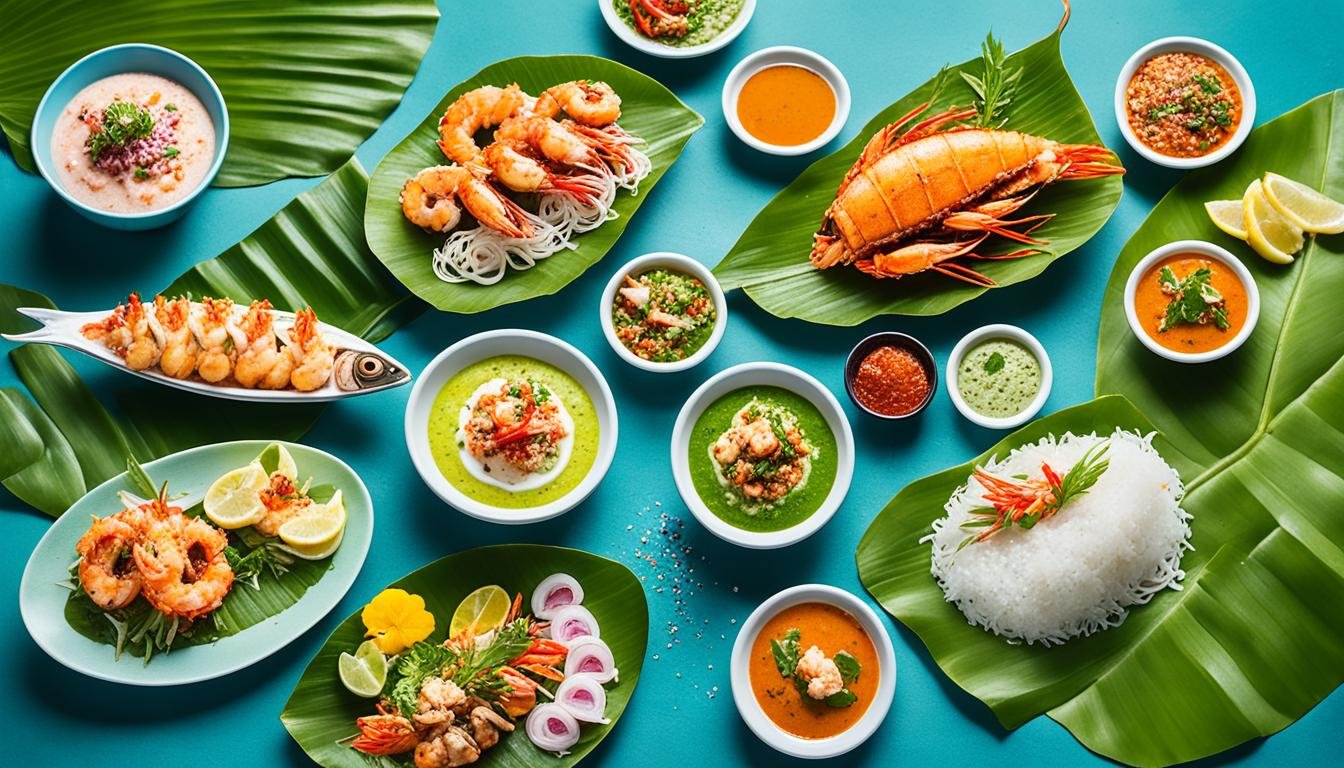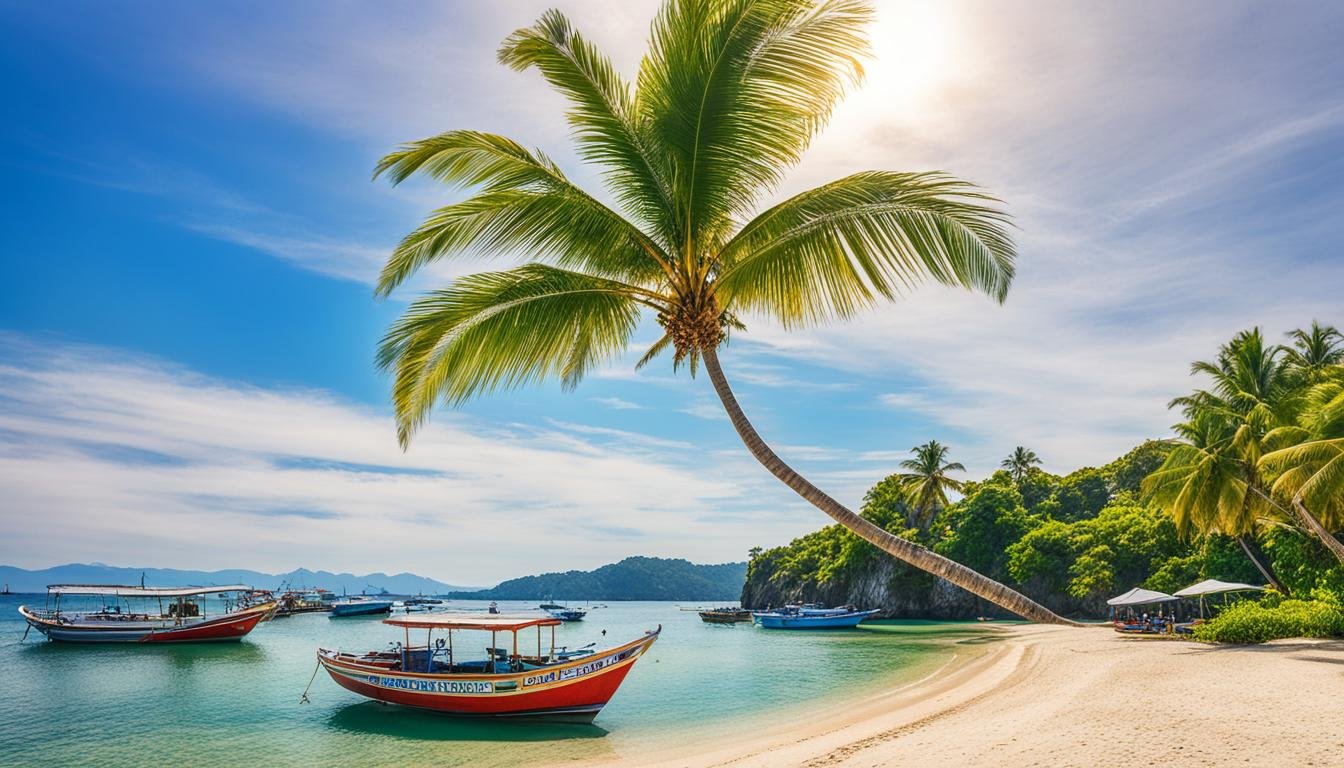If you’re someone who loves beautiful beaches, mouthwatering delicacies, and rich cultural traditions, then you’re in for a treat. Have you ever wondered what makes Pangasinan in the Philippines so special? What is it that sets this province apart from the rest? Prepare to be amazed as we take you on a journey through Pangasinan’s hidden gems, fascinating culture, and exquisite cuisine.
Key Takeaways:
- Discover the stunning natural beauty of Pangasinan’s beaches and tourist spots.
- Immerse yourself in the vibrant culture and traditions of Pangasinan.
- Indulge in the mouthwatering delicacies that make Pangasinan a culinary paradise.
- Uncover the history and meaning behind the name of this fascinating province.
- Learn practical tips for planning your trip to Pangasinan, including transportation options.
Pangasinan’s Natural Wonders
Pangasinan is blessed with a wealth of natural wonders, and the highlight among them is the Hundred Islands National Park. Located in the city of Alaminos, this group of 123 islands and islets showcases breathtaking beauty and unique geological formations.
The islands are scattered along the Lingayen Gulf, offering visitors the opportunity to explore pristine beaches, crystal-clear waters, and lush greenery. Each island has its own charm, with some featuring white-sand beaches, coral reefs, and hidden caves waiting to be discovered.
One of the most popular activities in the park is island hopping, where visitors can explore several islands in a single trip. The islands are accessible by boat, and there are options for both guided tours and private boat rentals.
Aside from beach activities, the park also offers opportunities for snorkeling, diving, kayaking, and even camping. Visitors can rent equipment or join organized tours to fully experience the natural beauty of the islands.
With its picturesque landscapes and diverse marine life, the Hundred Islands National Park is truly a gem in Pangasinan’s natural wonders. It attracts both local and international tourists, providing them with unforgettable experiences and stunning views.
A Culinary Paradise
Pangasinan is known as a culinary paradise, offering a wide array of delicious dishes and unique delicacies. One of the highlights of Pangasinan’s cuisine is its national fish, bangus or milkfish.
The Home of Bangus: Pangasinan’s National Fish
Bangus is a versatile fish that can be cooked in various ways, such as grilling, frying, and steaming. It is known for its tender and flavorful meat, making it a favorite among locals and visitors alike. Grilled bangus, paired with pinakbet (a vegetable stew), is a popular dish in Pangasinan.
Aside from bangus, Pangasinan is also famous for other seafood delicacies, such as bagoong (fish paste), which is a common condiment in Filipino cuisine. The province is also known for its longganiza (sausage), seafood dishes, and unique rice cakes called puto calasiao.
Exploring Pangasinan’s culinary scene is a must for food enthusiasts, as it provides an opportunity to taste the flavors of the province’s rich and diverse cuisine. From traditional dishes to innovative creations, Pangasinan’s culinary delights are sure to satisfy even the most discerning palate.

| Pangasinan Delicacies | Description |
|---|---|
| Bangus | A versatile fish known for its tender and flavorful meat |
| Bagoong | A common condiment in Filipino cuisine made from fermented fish or shrimp |
| Longganiza | A savory sausage made from ground pork and various spices |
| Puto Calasiao | A unique rice cake made from glutinous rice and coconut milk |
History and Culture that Lives On
The Meaning of Pangasinan: “Place of Salt”
The name Pangasinan carries a significant meaning that reflects the province’s history and culture. It is derived from the term “PanagASINan,” which translates to “where salt is made.” This name originated from the province’s coastal towns, which relied on salt-making as their main source of livelihood.
Pangasinan’s Rich Historical Background
Pangasinan has a rich historical background, with records dating back to the Spanish colonial era. It was conquered and colonized by D. Martin de Goiti in 1571, and it became an encomienda, a political unit, in 1572. April 5, 1580, is recognized as the official founding day of Pangasinan as a province.
Preserving Cultural Heritage through Festivals
The province has preserved its cultural heritage through various traditions and festivals celebrated by different towns and cities. These festivals showcase the unique cultures and popular livelihood resources of each locality. Visitors can witness vibrant street dances, colorful costumes, and traditional music during these festivities.
Historic Churches: Testaments to Faith and Devotion
In addition to its cultural traditions, Pangasinan is also known for its historic churches, such as the Minor Basilica of Our Lady of Manaoag and the St. Vincent Ferrer Statue in Bayambang. These churches serve as important religious sites and tourist attractions, reflecting the deep faith and devotion of the Pangasinense people.
Pangasinan’s Living History and Culture
Pangasinan’s history, culture, and traditions continue to thrive, providing a glimpse into the rich heritage of the province and its people.
Practical Tips for Your Pangasinan Trip
How to Get to Pangasinan
Pangasinan is conveniently located and accessible from various parts of the Philippines. For travelers coming from Manila, the capital city, there are several transportation options to reach Pangasinan.
By land, visitors can take a bus from Manila to Pangasinan. Buses operate regularly from different terminals in Manila, such as Cubao and Pasay. The travel time usually takes around 4-5 hours, depending on the traffic and the specific destination in Pangasinan.
For a more convenient and faster option, there are also private vans for hire that offer direct transportation from Manila to Pangasinan. This is ideal for groups or families who prefer a more personalized and comfortable travel experience.
Another option is to drive to Pangasinan using private vehicles. The province is accessible through major highways, and there are several routes to choose from depending on the starting point in Manila.
Once in Pangasinan, getting around the province can be done by local buses, tricycles, or hired vehicles. Public transportation is readily available in most towns and cities, offering a convenient way to explore the different attractions and destinations within Pangasinan.
It is advisable to plan the itinerary in advance and check the schedules and availability of transportation to ensure a smooth and enjoyable trip to Pangasinan.
Conclusion
Pangasinan is a truly remarkable destination that offers a perfect blend of natural beauty, delectable cuisine, and vibrant culture. Whether you’re a nature lover or an adventure seeker, the province has something for everyone. Its breathtaking beaches, idyllic islands, and lush hills provide a paradise-like experience.
Don’t miss out on Pangasinan’s culinary delights, especially the famous bangus or milkfish. The province’s gastronomic prowess shines through its diverse range of traditional and innovative dishes that are sure to satisfy even the most discerning palate.
Furthermore, Pangasinan’s rich history and cultural traditions make it a place with depth and character. From the unique meaning of its name to the preservation of ancient traditions and the vibrant celebrations of local festivals, the province proudly showcases its heritage.
When planning your trip to Pangasinan, consider your transportation options from Manila or nearby areas to ensure a smooth and hassle-free journey. Once you arrive, immerse yourself in the province’s beauty, flavors, and traditions. With its warm and welcoming people, Pangasinan will provide you with an unforgettable experience. Whether you’re seeking relaxation, adventure, or cultural immersion, Pangasinan is the perfect destination for your next trip.
FAQ
What is Pangasinan known for?
What are some popular tourist spots in Pangasinan?
What are some famous delicacies in Pangasinan?
What is the meaning of the name Pangasinan?
How can I get to Pangasinan?
What are the best places to visit in Pangasinan?
Source Links
- https://en.wikipedia.org/wiki/Pangasinan
- https://www.pangasinan.gov.ph/the-province/about-pangasinan/
- https://seepangasinan.com/about-us/about-pangasinan/
